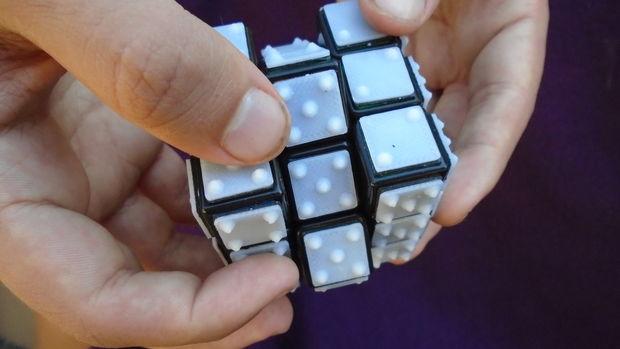
There are Rubik’s Cube competitions where you solve the Cube–not simultaneously, of course, although I would love to see that–with one hand, with your feet, while underwater, in a single breath, in the fewest possible moves, and even blindfolded.
One Instructables contributor, whom we know only by the puzzling screen name “liquidhandwash,” is a self-proclaimed “fixer, finder, [and] fabricator,” who decided to provide a close friend who is visually impaired with his own Braille Rubik’s Cube so he could experience the thrill (or, for many of us, intense frustration) of going head-to-head with the confounding cube. His friend had never seen a Rubik’s Cube before he’d lost his sight, so the concept was new to him.
“…I thought ‘How about I make a Braille Rubik’s Cube for him,’” wrote the thoughtful Australian. “Then he won’t have to miss out on all the frustration, exasperation, annoyance, anger, vexation, irritation, bitterness, resentment, disappointment and discouragement that comes with trying to solve that infernal puzzle.”
Aside from a 3D printer and a generous spirit, very little is required to accomplish this project. You’ll need a Rubik’s Cube as you will only be 3D printing plastic covers with Braille dots on them to cover the individual colored cube faces. You will also need a roll of double-sided automotive tape, some rubbing alcohol to clean the cube and 3D printed tiles, a sharp hobby knife for cutting, and a cutting surface.
You can download the .stl files from the Instructables page and follow the instructions, which are pretty simple. If you don’t have a 3D printer, all is not lost! You can click the easy “Print with 3D Hubs” button, or upload the .stl files to a 3D printing web service like Shapeways, Pinshape, or i.materialise. Once you have the the 3D printed Braille cube faces, you will want to remove the colored stickers (for easier adherence) and replace them with the plastic panels. You can lay the panels out on strips of double-sided tape and cut to the individual pieces.
As you likely noticed, the colors have been replaced by numbers from 1 to 6 (as, probably obviously, cubes are six-sided). Set the cube up like a die, with the opposite sides adding up to seven. For instance, ones are across from sixes and threes are across from fours. Evidently, the most challenging part of this project is putting the plastic panels on straight and the tape works really well so it isn’t particularly forgiving of an unsteady hand.
Honestly, I think the hardest part of this project is solving the darn thing–and it sounds like liquidhandsoap’s friend thought so, too. Good luck!
Will this be a project you’d undertake? What’s your favorite 3D printing project you’ve seen to assist the visually impaired? Let us know what you think over at the 3D Printed Braille Rubik’s Cube forum thread at 3DPB.com.
